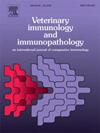猪肺炎支原体SBA-15灭活疫苗的促炎活性和免疫原性评价
IF 1.4
3区 农林科学
Q4 IMMUNOLOGY
引用次数: 0
摘要
猪肺炎支原体(M.)是猪地方性肺炎(PEP)的病原体,是猪呼吸道疾病复合体(PRDC)的主要病原体,它降低了猪生产的生产力,增加了猪生产的经济损失,疫苗接种是养猪场控制该病的最重要方法。本研究用SBA-15硅基佐剂对仔猪进行猪肺炎支原体灭活疫苗的促炎活性和免疫原性评价。48头断奶仔猪分为4组(n = 12头/组):商品疫苗组(CV);SBA-15佐剂疫苗组(SBA-15- vac);对照组接受不含抗原的PBS SBA-15悬液(SBA-15- cont),另一组接受生理盐水(NV)。SBA-15-Cont组作为佐剂相关效应的对照组,而NV组仅作为肺病变分析的阴性对照组。所有动物在接种疫苗后21天感染猪肺炎支原体菌株232。评估临床体征,并通过测定急性期蛋白和抗m。肺炎链球菌IgG和IgA抗体水平。SBA-15佐剂对照组在接种疫苗后表现出轻微的炎症反应,维持稳定的转铁蛋白和触珠蛋白水平,表明与商业疫苗相比,炎症反应受到控制。SBA-15组表现出延迟但持续的免疫反应,表明可能存在储存效应。急性期蛋白水平,特别是铜蓝蛋白和触珠蛋白。我们的研究结果支持SBA-15作为一种安全有效的佐剂的潜力,并强调SBA-15二氧化硅纳米颗粒是猪肺炎支原体疫苗中一种有前途的安全佐剂。本文章由计算机程序翻译,如有差异,请以英文原文为准。
Evaluation of pro-inflammatory activity and immunogenicity of an inactivated SBA-15 silica vaccine against Mycoplasma hyopneumoniae in piglets
Mycoplasma (M.) hyopneumoniae, the agent of porcine enzootic pneumonia (PEP), a primary pathogen of porcine respiratory disease complex (PRDC), reduces productivity and increases economic losses in swine production, with vaccination being the most important method to control the disease in the producing farms. This study evaluates the pro-inflammatory activity and immunogenicity of an inactivated vaccine for M. hyopneumoniae using an SBA-15 silica-based adjuvant in piglets. Forty-eight weaned piglets were divided into four groups (n = 12/group): a commercial vaccine group (CV); an SBA-15 adjuvanted vaccine group (SBA-15-Vac); a control group, receiving a suspension of SBA-15 with PBS, without the antigen (SBA-15-Cont), and a group that received saline solution (NV). SBA-15-Cont group served as a control for adjuvant-related effects, while the NV group served as negative control for lung lesion analysis, only. All animals were challenged, 21 days post vaccination, with M. hyopneumoniae strain 232. The evaluation of clinical signs was performed, and the inflammatory response was evaluated by measuring acute-phase proteins, as well as anti-M. hyopneumoniae IgG and IgA antibody levels. The SBA-15 adjuvant control group demonstrated mild inflammatory responses maintaining stable transferrin and haptoglobin levels after vaccination, suggesting a controlled inflammatory response compared to the commercial vaccine. The SBA-15 group exhibited a delayed but sustained immune response, suggesting a possible depot effect. Acute-phase protein levels, particularly ceruloplasmin and haptoglobin. Our findings support the potential of SBA-15 as a safe and effective adjuvant and highlight that SBA-15 silica nanoparticles are a promising and safe adjuvant in swine vaccines against M. hyopneumoniae.
求助全文
通过发布文献求助,成功后即可免费获取论文全文。
去求助
来源期刊
CiteScore
3.40
自引率
5.60%
发文量
79
审稿时长
70 days
期刊介绍:
The journal reports basic, comparative and clinical immunology as they pertain to the animal species designated here: livestock, poultry, and fish species that are major food animals and companion animals such as cats, dogs, horses and camels, and wildlife species that act as reservoirs for food, companion or human infectious diseases, or as models for human disease.
Rodent models of infectious diseases that are of importance in the animal species indicated above,when the disease requires a level of containment that is not readily available for larger animal experimentation (ABSL3), will be considered. Papers on rabbits, lizards, guinea pigs, badgers, armadillos, elephants, antelope, and buffalo will be reviewed if the research advances our fundamental understanding of immunology, or if they act as a reservoir of infectious disease for the primary animal species designated above, or for humans. Manuscripts employing other species will be reviewed if justified as fitting into the categories above.
The following topics are appropriate: biology of cells and mechanisms of the immune system, immunochemistry, immunodeficiencies, immunodiagnosis, immunogenetics, immunopathology, immunology of infectious disease and tumors, immunoprophylaxis including vaccine development and delivery, immunological aspects of pregnancy including passive immunity, autoimmuity, neuroimmunology, and transplanatation immunology. Manuscripts that describe new genes and development of tools such as monoclonal antibodies are also of interest when part of a larger biological study. Studies employing extracts or constituents (plant extracts, feed additives or microbiome) must be sufficiently defined to be reproduced in other laboratories and also provide evidence for possible mechanisms and not simply show an effect on the immune system.

 求助内容:
求助内容: 应助结果提醒方式:
应助结果提醒方式:


